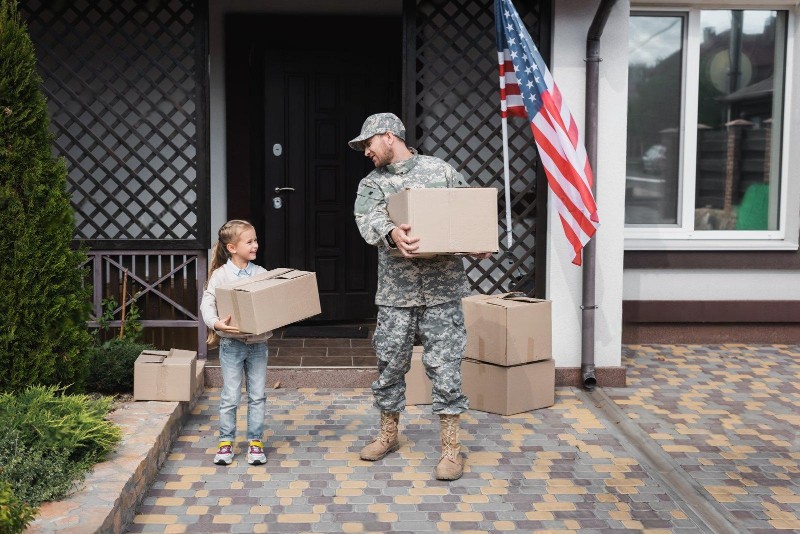
Active-duty service personnel and Veterans are eligible to apply for the VA home loan benefit program.
The VA home loan benefit has helped millions of Veterans, service members, and military families achieve homeownership since its creation in 1944 under the original GI Bill of Rights.
With the Permanent Change of Station (PCS) season approaching, military families face fast timelines, balancing school transitions, housing searches, and career adjustments. This guide offers a practical overview of the VA loan program—its benefits, eligibility requirements, and role in a competitive housing market—to help you make confident, informed decisions.
Table of Contents:
WHAT IS A VA LOAN?
A VA loan is a home financing option backed by the U.S. Department of Veterans Affairs (VA). It’s available to Veterans, active-duty service members, and surviving spouses. While the loan is issued by private lenders—such as banks or mortgage companies—the VA guarantees a portion, reducing lender risk and enabling them to offer more favorable terms.
VA loans can be used to purchase a single-family home, condominium, multi-unit property, or new construction. Most borrowers qualify for lower interest rates and no down payment. The goal is to make homeownership more accessible to those who have served.
A closer look at VA home loan benefits:
- No downpayment required by VA: While lenders may impose their own standards, the VA itself does not require a downpayment.
- No private mortgage insurance (PMI): VA loans do not require private mortgage insurance, which helps lower monthly costs.
- Lower interest rates: VA-backed loans typically offer competitive interest rates compared to standard financing.
- Flexible credit criteria: Applicants with imperfect credit may still be eligible.
- Capped closing costs: The VA limits certain fees lenders can charge.
- Reusable benefit: The VA home loan is a lifetime benefit and can be restored after payoff or sale, allowing multiple uses over a lifetime.
Who is eligible for a VA loan?
Active duty service members, Veterans, members of the National Guard or Reserves may be eligible for a VA home loan. Eligibility typically depends on length of service, duty status, and discharge type. Some surviving spouses also qualify.
You may meet the requirements for VA loans if you are:
- An active-duty service member with at least 90 continuous days of service
- A veteran who meets minimum service criteria based on your separation date
- A National Guard or Reserve member with qualifying service
- A surviving spouse who receives (or is eligible) for Dependency and Indemnity Compensation (DIC) and has not remarried, or remarried after age 57
Obtaining a Certificate of Eligibility (COE)
Before applying, lenders must verify your eligibility through a Certificate of Eligibility (COE). This document confirms that you meet the service-based requirements for VA loans.
Most lenders can request for a COE electronically using your Social Security number and date of birth. If needed, you can also apply on your own through the following methods:
- Online: Apply through the VA’s eBenefits portal
- Through your lender: Many lenders can retrieve it on your behalf
- By mail: Complete VA Form 26-1880 to the VA
- For surviving spouses: Submit VA Form 26-1817 with any required documentation
The VA loan benefit is reusable. It can be restored after a sale or full payoff.
HOW THE VA LOAN PROCESS WORKS
- Step 1: Get preapproved
Preapproval shows you’re a serious buyer. Your lender will review your credit, income, employment, and service history to determine loan eligibility and set a preliminary borrowing limit.
- Step 2: Start the search
Work with a real estate agent experienced with VA loans. Eligible properties must be used as your primary residence, and must meet the VA’s minimum standards. Multi-unit properties (up to four units) may qualify, provided you occupy one of them.
- Step 3: Make an offer
Your agent will determine a competitive price based on local sales. Your lender can estimate closing costs and guide you on structuring contingencies. VA home loan benefits include protections; if the appraisal comes in low and you opt out, your earnest money is typically refunded.
- Step 4: Appraisal and underwriting
Once you’re under contract, the VA loan process begins. The VA assigns an independent appraiser to evaluate the home’s value and basic condition. You’ll usually pay the appraisal fee upfront. The underwriter will then review your file to confirm it meets all requirements for VA loans.
- Step 5: Closing
Before settlement, you will receive a Closing Disclosure with the final loan terms and fees. Review it carefully with your loan officer. A final walkthrough ensures the property is in agreed-upon condition. If all checks out, you’ll sign closing documents and receive your keys.
DEBUNKING VA HOME LOAN MYTHSThere is no shortage of misinformation about VA home loans. Here are four persistent myths—and the facts that disprove them.
|
MAKE THE MOST OUT OF YOUR BENEFITS
VA home loans remain one of the most competitive financing options available, requiring no down payment, no private mortgage insurance, and offering consistently favorable interest rates.
As a Military Relocation Professional (MRP), I understand the time-sensitive nature of PCS moves and how important it is to plan early. If you’re preparing for a relocation and want to understand your options—both in VA loans and Northern Virginia homes— call 703.298.8421 or send me a message so we can discuss your next steps.
